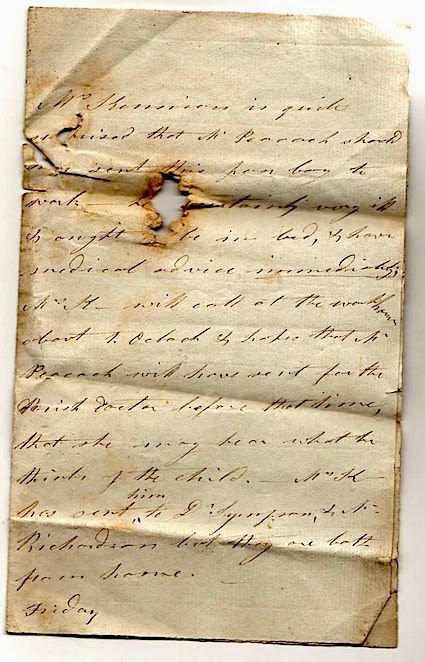Here is a letter picked up years ago in London among a box of ephemera. It is undated, though the watermark is 1821. It is addressed to ‘Mr or Mrs Peacock’:
Mrs Kennion is quite surprised that Mr Peacock should have sent this poor boy to work. He was certainly very ill & ought to be in bed & have medical advice immediately. Mrs K will call at the workhouse about 1 o’clock & hopes that Mr Peacock will have sent for the Parish doctor before that time,that she may hear what he thinks of the child. Mrs K has sent him to Dr Sympson & Mr Richardson, but they are both from home.
Friday.
A bit of Googling revealed that the action took place in Harrogate, then just beginning on its journey to becoming the most select watering place in the north of England. In June 1822 Henry Peacock, formerly the master of Aldborough and Boroughbridge workhouse, arrived, with his wife Elizabeth, as the master of Harrogate’s workhouse in Starbeck. Evidently aiming to make an impression with the employers by saving money, the couple soon managed to reduce the average cost of keeping a pauper by establishing what was basically a vegetarian diet. This regimen could have contributed to the poor health of the boy in question. It would probably not have included many, if any, fresh vegetables, and may, like that of the hero of Oliver Twist, which was set in the 1820s, have consisted mainly of gruel.
According to one historian of Harrogate, writing in 2005, Peacock did have a compassionate side to him and went out of his way to help inmates get employment. However, there is also evidence that the regime at Starbeck was harsh:
‘The work was long and arduous and the rules strictly adhered to and punishments were severe. The punishment for missing church was to be held in a dark room and the forfeit of the next meal. The missing of a meal could seriously affect an inmate’s ability to work the next day, which would incur punishment…’
Sad Demise of Henry Peacock, Sunderland Echo, 23/2/2005
The compassionate Mrs Kennion, who was so concerned for the welfare of the anonymous boy, was the wife of Reverend Thomas Kennion, curate of St John’s Harrogate. There is no record of a Dr Sympson (or Simpson) in Pigot’s Yorkshire Directory of 1828, but a Robert Richardson is listed there as a surgeon working in Harrogate. As for the boy, it would good to know what became of him. Luckily we do know what happened to Henry Peacock. After being involved in a number of dodgy financial transactions while at Starbeck, he was finally sacked in 1838. He then failed as a hotelier in Harrogate and after migrating to his native town of Richmond and becoming a joiner and cabinet maker, died there of natural causes in 1877, probably in his late eighties.

